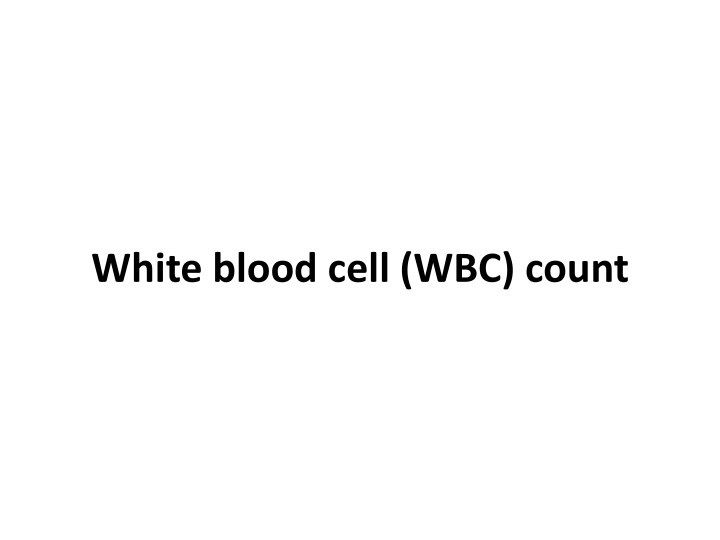
White Blood Cell (WBC) Count and Methods
Learn about the importance of white blood cell (WBC) count, its normal range, and methods for manual counting using a haemocytometer. Discover the materials, procedure, and calculation involved in determining the WBC count, essential for assessing infections and disease progression.
Download Presentation

Please find below an Image/Link to download the presentation.
The content on the website is provided AS IS for your information and personal use only. It may not be sold, licensed, or shared on other websites without obtaining consent from the author. If you encounter any issues during the download, it is possible that the publisher has removed the file from their server.
You are allowed to download the files provided on this website for personal or commercial use, subject to the condition that they are used lawfully. All files are the property of their respective owners.
The content on the website is provided AS IS for your information and personal use only. It may not be sold, licensed, or shared on other websites without obtaining consent from the author.
E N D
Presentation Transcript
Introduction and principle White blood cell count denotes the number of white blood cells per unit volume of whole blood. Normal WBC count range from 4000 - 11000 cell / mm3 this count varies with age. WBC count is useful to indicate infections or may be employed to follow the progress of certain diseases. White blood cells in the circulation are not white in the sense that a sheet of white paper is white, but in the sense that they are transparent and not coloured. White cells are fewer in number than red cells. White blood cells are counted in a similar manner to red cells, using a haemocytometer.
Methods 1- Manual method. 2- Electronic cell counting .
Manual method Materials & instrument Anticoagulated whole blood or capillary blood can be used. Turk s solution composed of : 3 ml Glacial acetic acid to haemolyze RBCs. 1 ml Aqueous Gention violet (1% w/v) to color WBC nuclei Up to 100 ml Distilled water WBC pipette: it is composed of a stem, mixing chamber, white bead inside the mixing chamber, aspiration tube (rubber sucking tube) Haemocytometer (Neubauer s counting chamber) with a cover slip. Microscope. Lancet. Cotton
Procedure: 1.Obtain a drop of blood in the same manner as in RBC count. Draw blood up to the mark 0.5 using WBC pipette. 2.Aspirate diluting fluid up to mark 11. The dilution is 1:20. 3.Remove blood from outside of the pipette with a clean gauze 4.Gently rotate the pipette horizontally with your hand to ensure a proper amount of mixing for 3 minutes. 5.After mixing discard the first four drops of the mixture.
6-Fill the counting chamber with diluted blood by holding the pipette at 45owith the slide and allow the mixture to seep under the cover slip, the filled chamber should be allowed to stand for a minute prior to counting. 7-Count the WBCs using the low power 10 x objectives. 8-Count all WBCs in four large corner squares and add the result together to obtain the total number of cells counted. In counting the cells that touch the outside lines of the large square, count only those that touch the left and lower outside margin. The WBCs look like black dots.
Calculation: Count the number (N) of cells in the large squares located at the four corners of the chamber. The size of each large squares = 1 mm x 1 mm x 1/10 mm x 4 = 4/10 mm3 1 mm is the length of each sideline of each square 1/10 mm is the depth of the counting chamber between coverslip and the ruling 4 is the number of large squares used to count. The total numbers of cells in 1 mm3are = N x 10/4 (diluted sample) The actual total number of cells before dilution should be = N x 10/4 x 20 = N x 50
Medical considerations Leucocytosis: increased WBCs number which could be physiological (at afternoon, eating, physical activity, stress, pregnancy, and labor) or pathological (e.g. acute infection, drugs, after surgical removal of the spleen (splenectomy)). Leucopenia: decreased WBCs number which could be physiological (at morning, newborns, and infants) or pathological (e.g. chronic infection, drugs) Leukemia: a group of malignant disorders of the haemopoietic tissue in which there is failure of cell maturation with proliferation of primitive WBCs (blast cells) in the bone marrow and spread into the blood.










